Welcome to our extensive guide featuring the top flooring company websites, carefully selected by our accomplished team of web designers and developers.
With a discerning eye for excellence, we’ve examined hundreds of flooring company websites, ranking them based on crucial factors such as design, functionality, uniqueness, user experience, and other essential grading criteria. Our objective is to provide flooring companies with a rich source of inspiration and ideas for their next website, ensuring an online presence that effectively showcases their products and services while captivating potential clients.
In this article, we’ll delve into the vital components of a successful flooring company website, including intuitive navigation, engaging visuals, informative product descriptions, customer testimonials, and a seamless quote request process that caters to both residential and commercial clients. This isn’t our first similar article – if you refer to our best designed websites article you’ll find a collection of thousands of amazing websites organized into dozens of different business industries.
So, join us as we journey through the world of exceptional flooring company web design, and learn how to create an online experience that elevates your brand and drives customer inquiries.
Top Flooring Company Website Designs
1. Unique Wood Floors
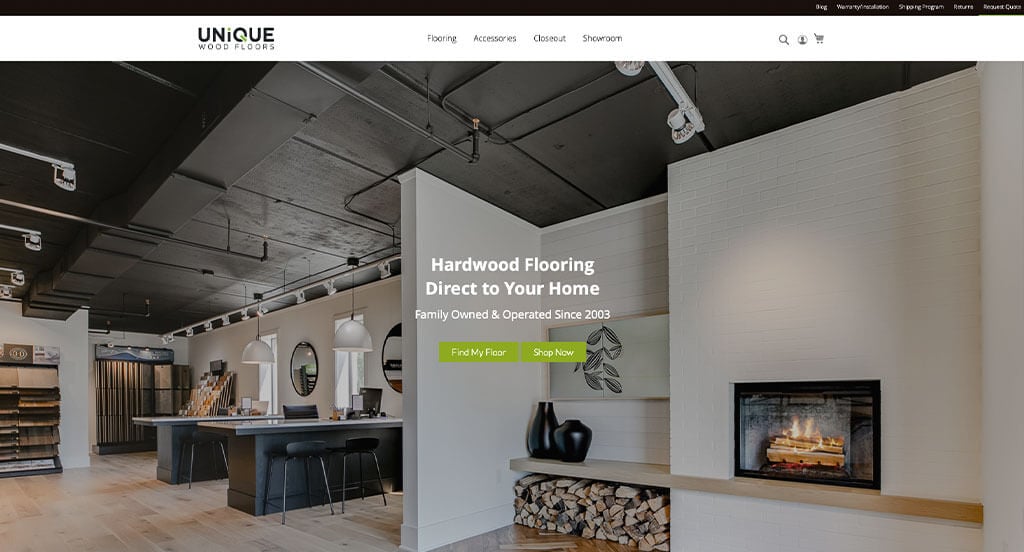
There were numerous flooring companies to choose from, but the website for Unique Wood Floors was the perfect example of a well-designed layout with a black, white and green color scheme. The stunning visuals were likely the most impactful quality in the homepage of this website. The impact of their written information was another unique quality in this professional flooring site we enjoyed. Unique Wood Flooring clearly had website marketing in mind when building the navigation bar with organized categories for their website. Give some thought to the one-of-a-kind design of this flooring website when building out your next website.
2. Michigan Carpet & Flooring
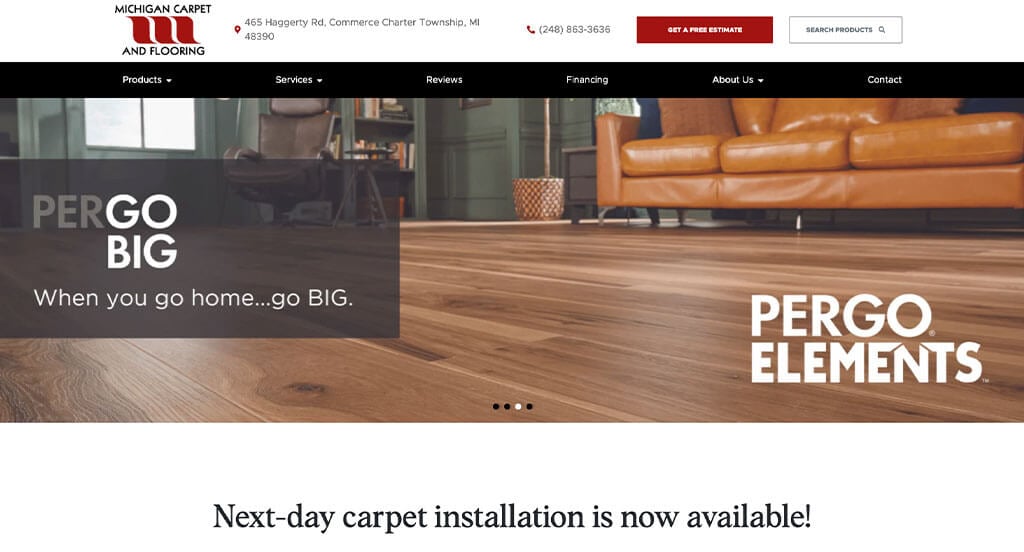
The red, black and white color scheme used in this flooring site stood out to us because the red wasn’t overpowering. As you scroll through the homepage, one of the qualities you’ll notice right away is their unique placement for their imagery. The ability to request an estimate was a good choice for a unique flooring site. They had digital marketing in mind when creating the simple contact information for their website. For flooring businesses looking for ideas on their next website, this example will definitely be one to take a look at.
3. Lakeside Floor Coverings
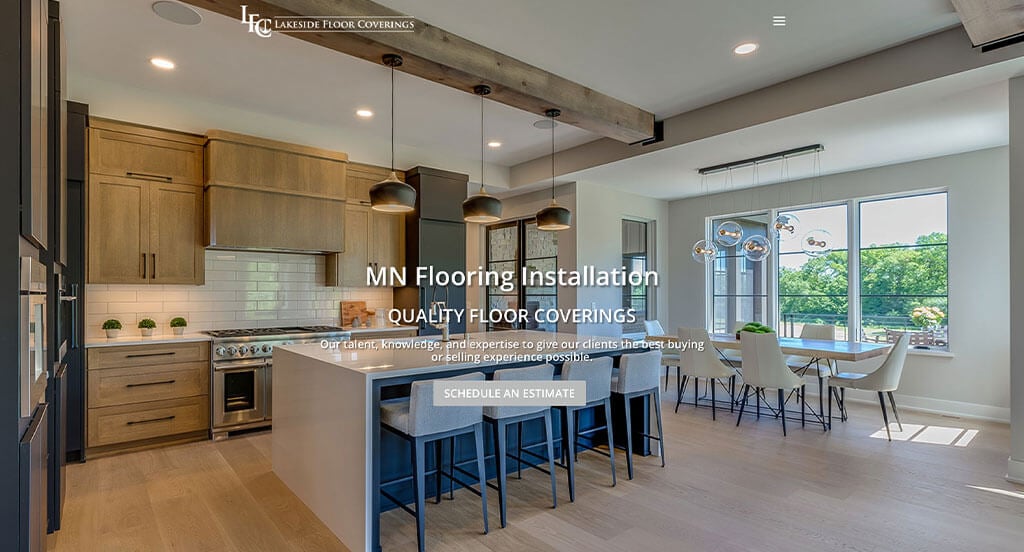
This is a good example of a flooring website design to check out when looking for inspiration fir a professional looking website. After scrolling past the header of this flooring website, you’ll notice their basic layout that is easy for viewers to navigate. Another thoughtful quality in this custom flooring site we liked was their large and labeled buttons. The section for customer reviews helped make this one of the best flooring websites we reviewed. Be sure to consider the unique design of this flooring website when building out your next website.
4. Quick Floors
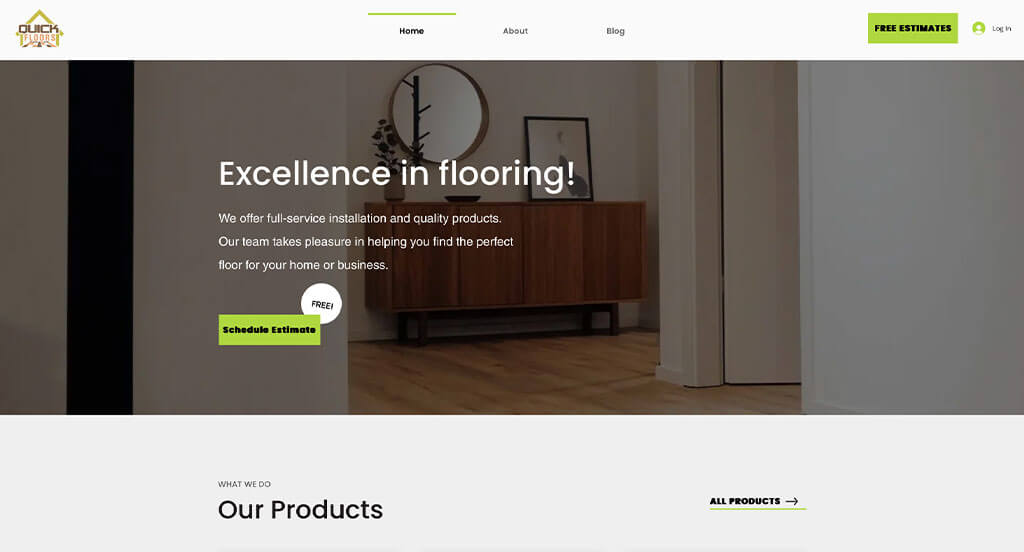
This is a great flooring web design example for someone looking for a professional layout. The the use of subtle graphics for their background was likely the most impactful feature in the homepage of this website. Their interesting logo design was another feature in this professional flooring website we enjoyed. They clearly had a focus on website accessibility when designing the bright green for links within their website. What a great website to review when designing your next flooring website!
5. Michigan Floor Coverings
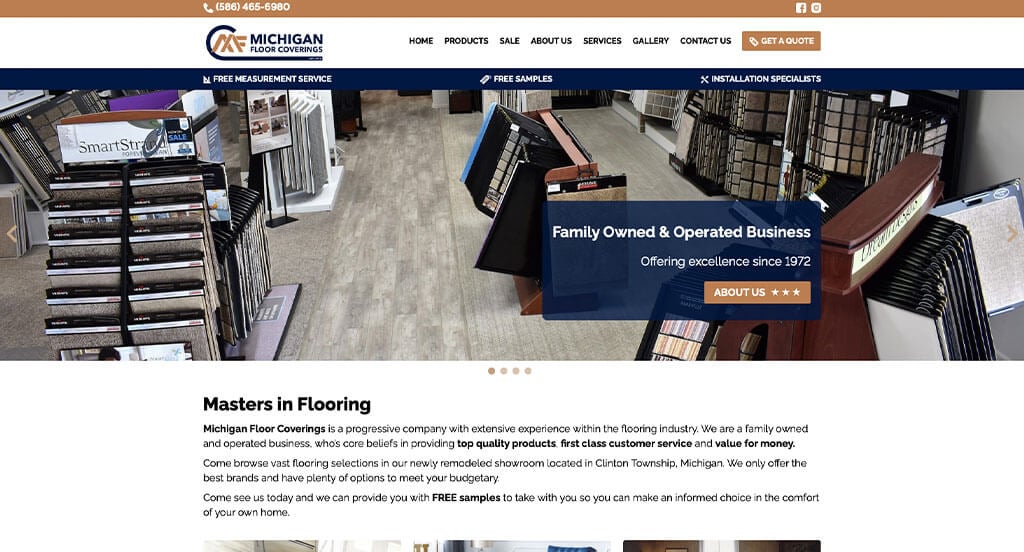
This is a good example of a website design for flooring companies who are looking for a professional website design. After scrolling past the header of this flooring website, you’ll notice their dark blue banners to show important information. Another thoughtful feature in this custom flooring website was their professional color palette. They had conversions in mind when creating the planned out imagery for their website. If you are looking for template ideas for your next flooring site, give some thought to this one.
6. LL Flooring
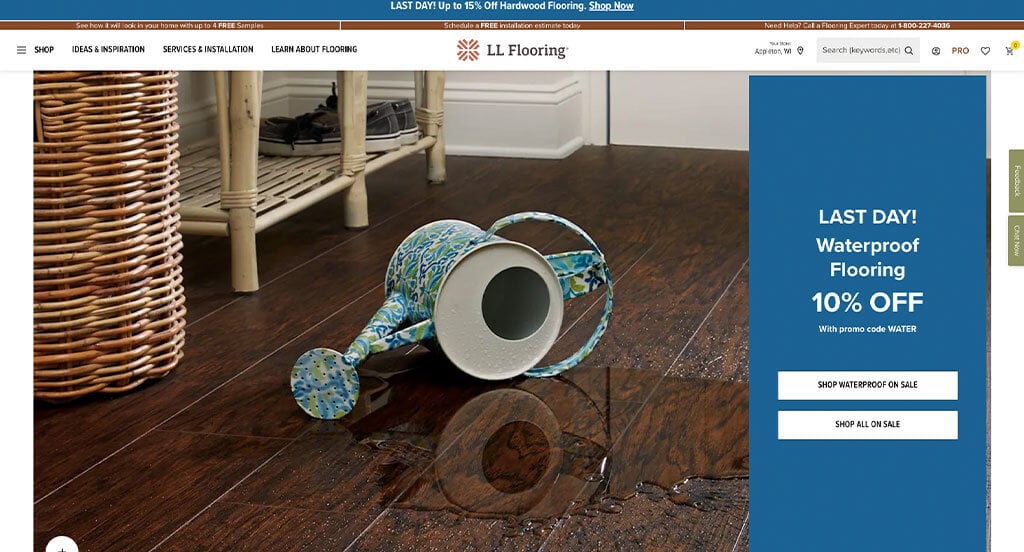
This is a great example for flooring companies who are looking for a professional website layout. We thought this was a good homepage design example for flooring businesses because of their layout that was free of distractions. The titles for their imagery that also served as buttons was another design quality in this custom flooring site we enjoyed. They clearly had ease of use in mind when building the domain for their website that matches their company’s name. So many attractive qualities to consider when ranking this website.
7. Floors by Roberts
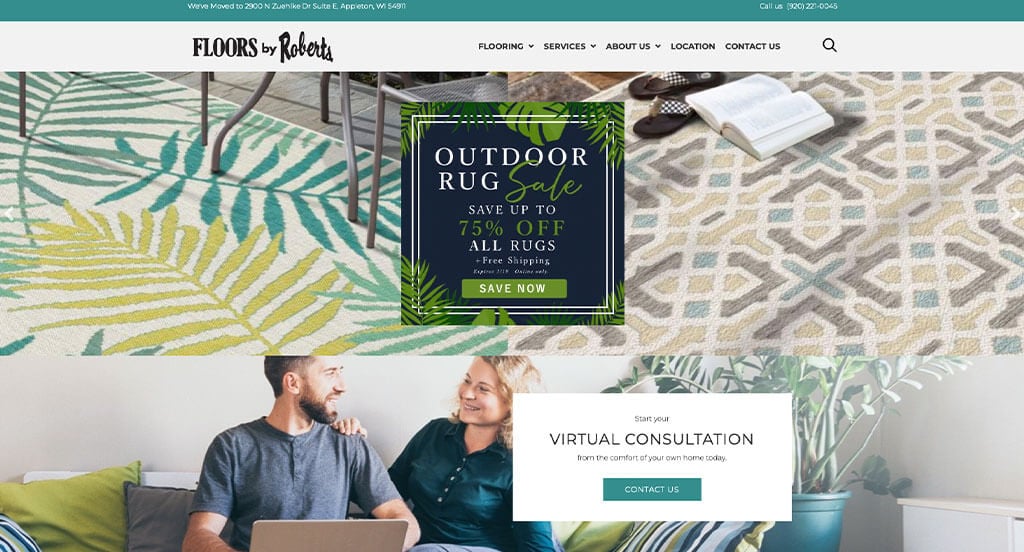
We appreciated how this flooring site used the colors of blue, white and black to create an attractive website design. While most flooring websites share this quality, we thought Floors by Roberts did a nice job with their area for flooring “samples”. The trending now section was a nice touch for a custom website. Floors by Roberts clearly had conversions in mind when designing the short and to the point paragraphs for their website. Don’t skip past this website when hunting for design ideas for your next flooring website!
8. Creative Flooring
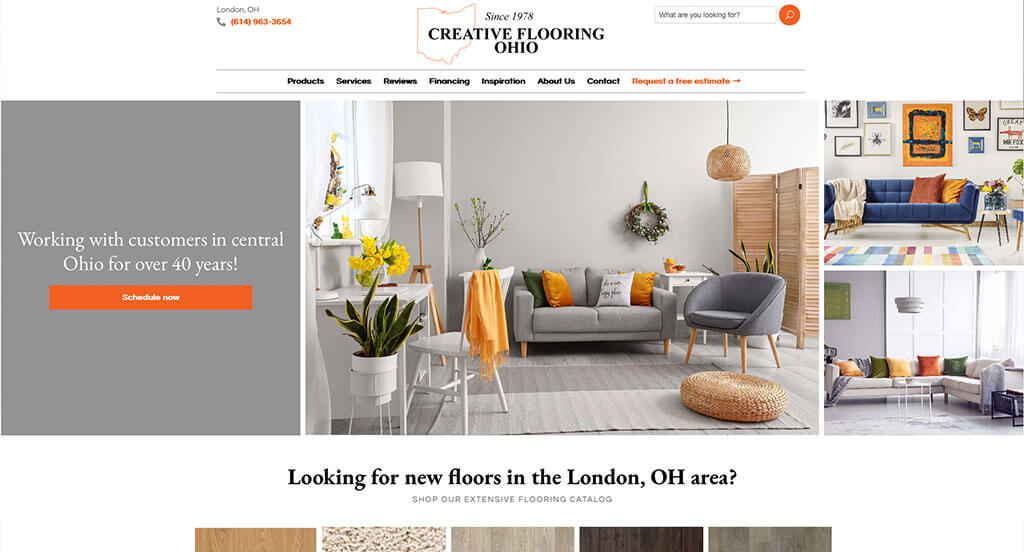
This is a great web design example for flooring companies who are looking for a professional look and feel. The use of orange as an accent color was likely the most impactful feature in the homepage of Creative Flooring. Another feature in this creative flooring site was their layout for their imagery. From a marketing perspective, for a flooring website we liked the way they utilized an organized template for their written information. Any website designer building websites for flooring businesses will want to consider checking this website out.
9. Signature Custom Flooring
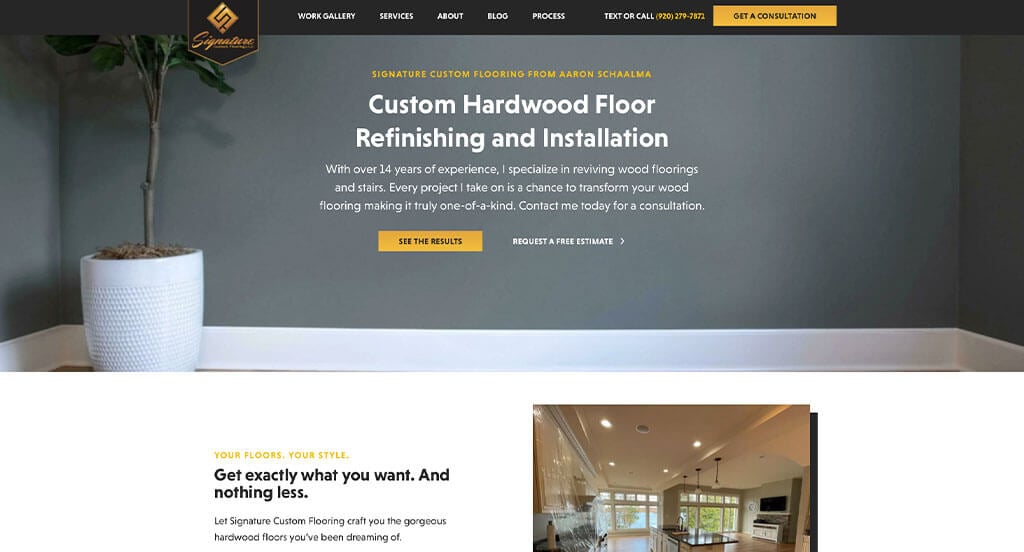
This is a good example of a website design for flooring companies who are looking for a professional website layout. One of the design features we liked most on the homepage of Signature Custom Flooring was their thoughtful logo design because it was rather refreshing for a flooring website. The inclusion of a blog was another thoughtful feature in this custom flooring site we enjoyed. Signature Custom Flooring clearly had a focus on ease of use when building the photo gallery for their website. Be sure to consider the great design of this flooring website when building your next website.
10. D&M Interiors
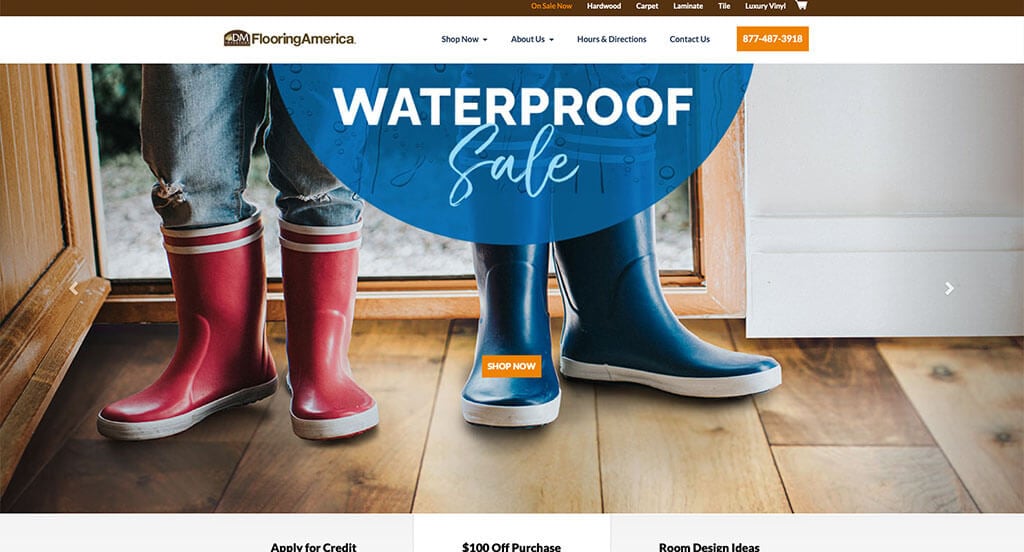
The website of D&M Interiors ranked because it’s one of the better looking flooring websites we came across. The use of bolded font to help certain words stand out was definitely the most impactful feature in the homepage of this website. The progression bar placed at the top of the page was another reason why we included this website in our list of the best websites for flooring. D&M Interiors clearly had digital marketing in mind when creating the simple navigation of their website. With so many quality reasons to consider this flooring website, it’s no wonder we included it in this list of the best sites!
11. Johnson’s Flooring
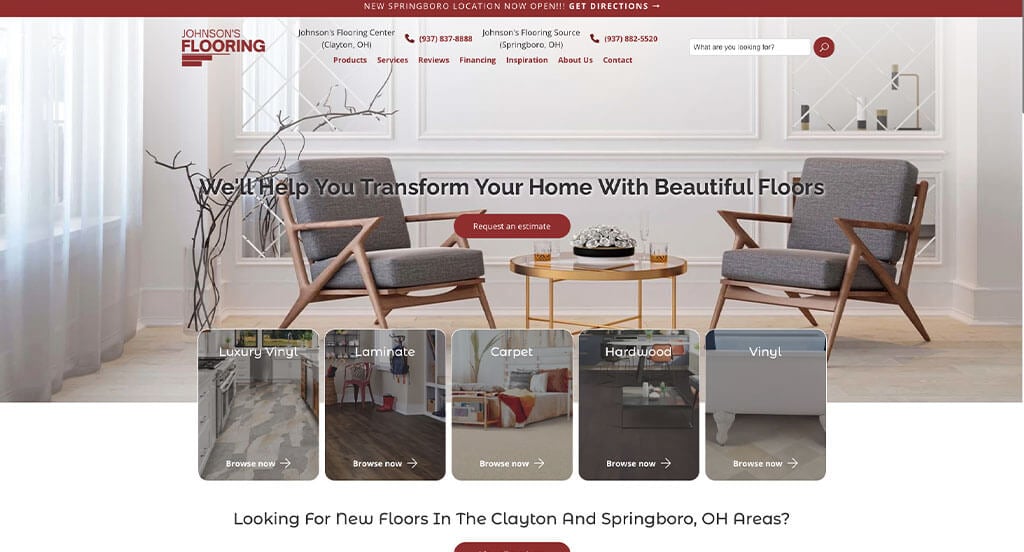
The white and red color scheme used in this custom flooring site stood out to us because the colors balance out each other. One of the homepage features of Johnson’s Flooring we noticed was their use of easy to find buttons because it was rather refreshing for a flooring website. Another thoughtful feature in this custom flooring website we liked was their short and to the point paragraphs. Johnson’s Flooring clearly had a focus on internet marketing when designing the domain for their website that matches their company’s name. For flooring companies looking for examples for their next website layout, this design example will absolutely be one to keep in your back pocket.
12. Columbus Flooring City
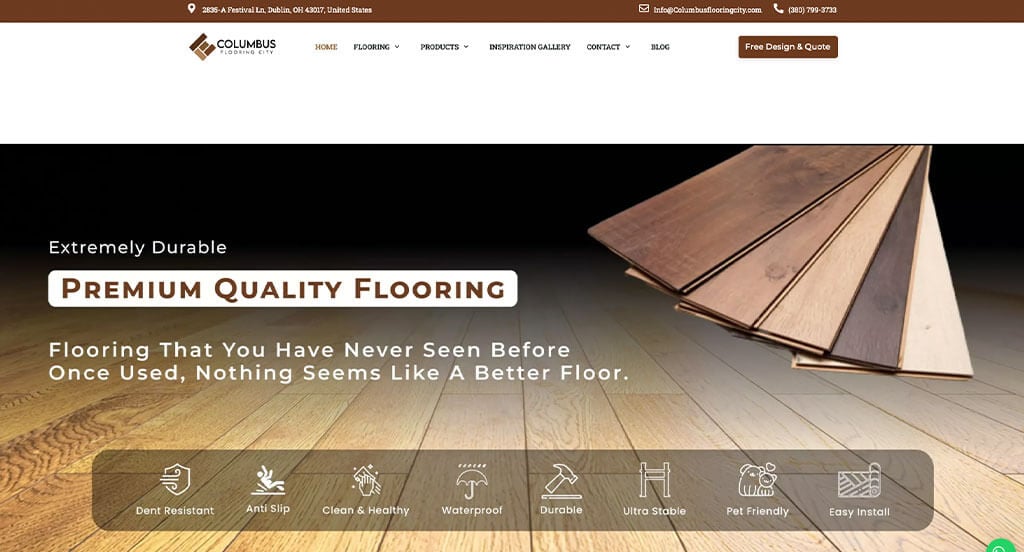
This is a great website design example for flooring companies who are looking for a custom look and feel for their next custom site. While most flooring websites share this quality, we thought Columbus Flooring City did a nice job with their color palette that matches their company. This clean flooring website also does a good job with their use of icons. They had website accessibility in mind when creating the simple contact information for their website. If you are looking for template options for your next flooring website, be sure to check this one out.
13. America’s Floor Source
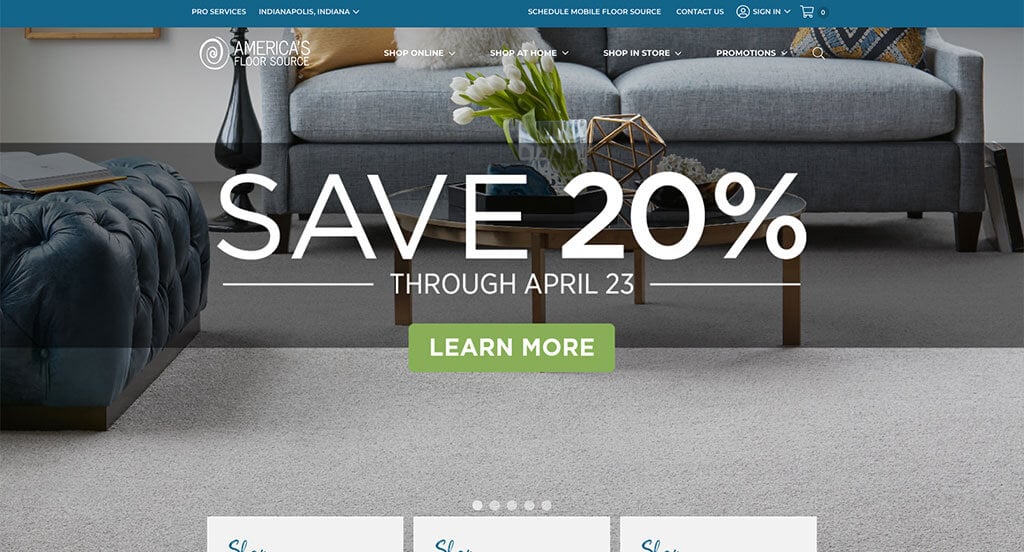
This is a good example of a website design for flooring companies who are looking for a professional look and feel for their next website. The captivating fonts were definitely the most impactful feature in the homepage of this website. Another design quality in this creative flooring site was the use of square-like frames and color blocks to add a feeling of unity. America’s Floor Service clearly had a focus on digital marketing when building the domain for their website that matches their company name for their website. What a great website to review when building out your next website!
14. Lifestyle Flooring
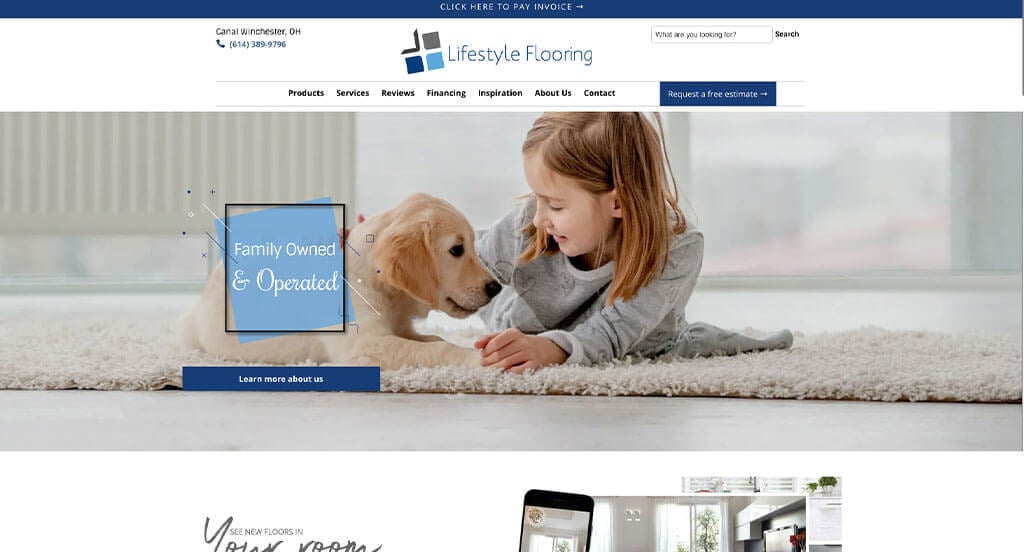
This is a great flooring web design example for someone who is looking for a professional layout. The variety of blue tones was probably the most impactful quality in the homepage of this website. Another design quality in this creative flooring site was their layout that was easy to navigate. Their simple contact information helped make this one of the top flooring websites we looked at. Give some thought to the unique design of this flooring website when developing your next website.
15. Great Floors
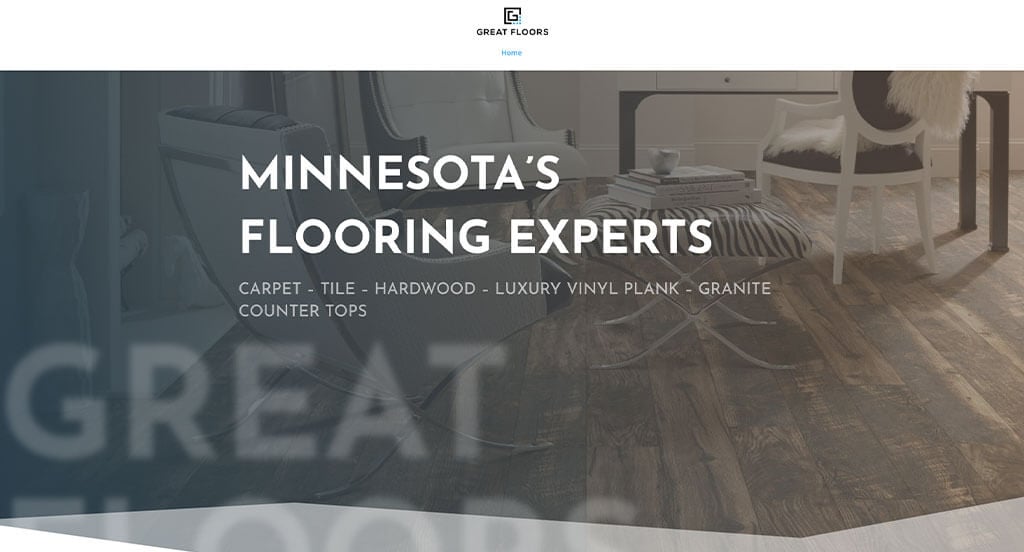
This is a good example of a flooring website design to check out when looking for a professional website layout idea. After scrolling past the navigation of this flooring website, you’ll immediately notice the creative logo design. The different sized fonts to show off the titles was another feature in this custom flooring site we enjoyed. Great Floors clearly had a focus on website marketing when designing the wavy patterns for the backgrounds for their website. Any website designer building websites for flooring businesses will want to consider checking this website out.
16. S&B Flooring and Tile
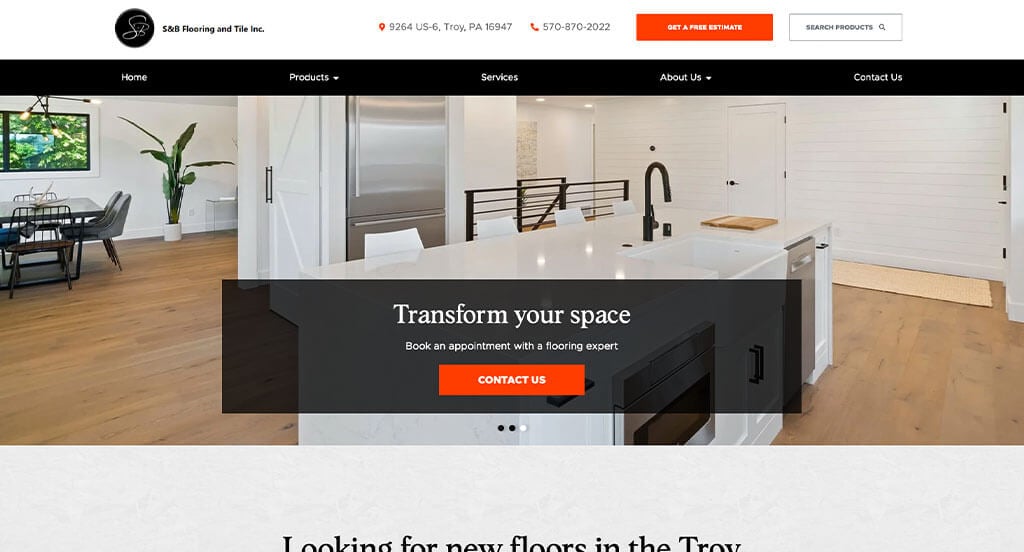
This is a creative website design example for a flooring company that is looking to build their next custom website. The high-quality visuals were probably the most impactful quality in the homepage of this website. The basic, but stunning logo design was another feature of this custom flooring website we enjoyed. They clearly had website marketing in mind when creating the orange accent color for their website. Be sure to consider the one-of-a-kind design of this flooring website when building your next website.
17. Garvey’s
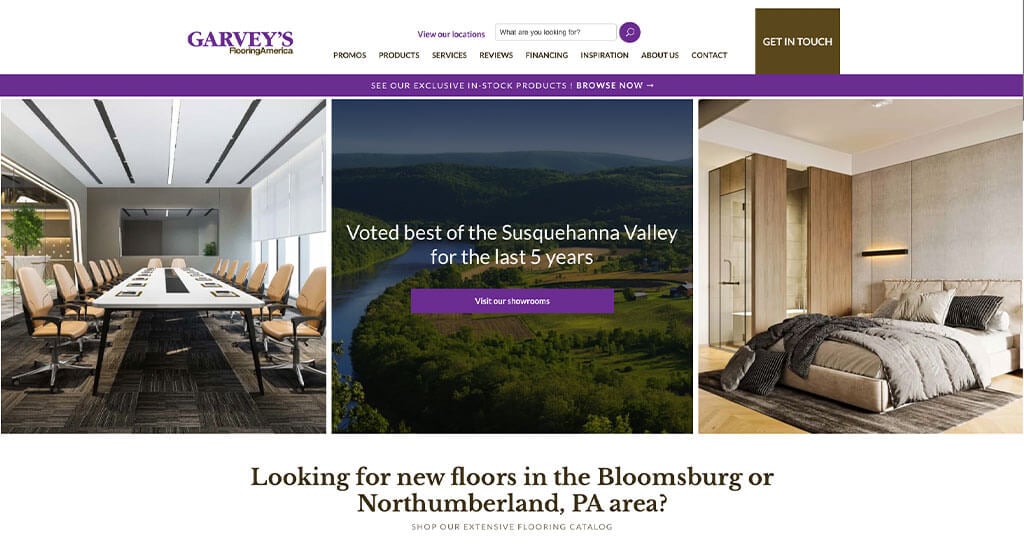
The Garvey’s website has a very professional feel to it, thanks to its unique use of white, purple, and black. Our web designers thought this was a good homepage design example for flooring companies because of their use of buttons for simple navigation. This professional flooring website also does a good job with short and to the point paragraphs. They had digital marketing in mind when creating the variety of image sizes for their website. Talk about a great website to have included in this list!
18. Sunshine Flooring
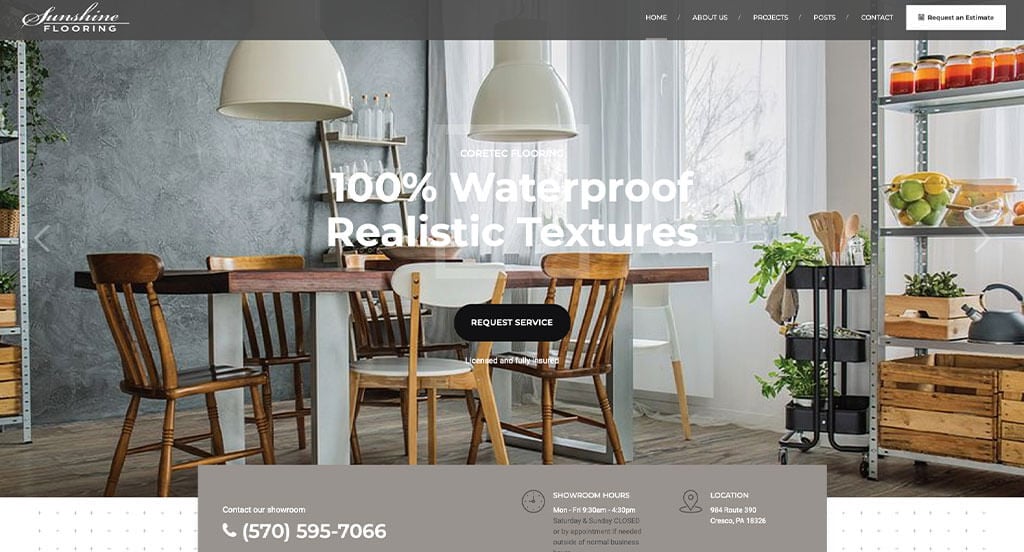
The website of Sunshine Flooring ranked because it’s one of the nicer flooring websites we have encountered. The experimentation of opacity was likely the most impactful quality in the homepage of this website. The page dedicated to their showroom was another thoughtful feature in this professional flooring site we enjoyed. Sunshine Flooring clearly had a focus on website usability when adding a blog into their website. Don’t forget to check this website out while looking through our list of the best flooring websites!
19. Spectrum of Floors
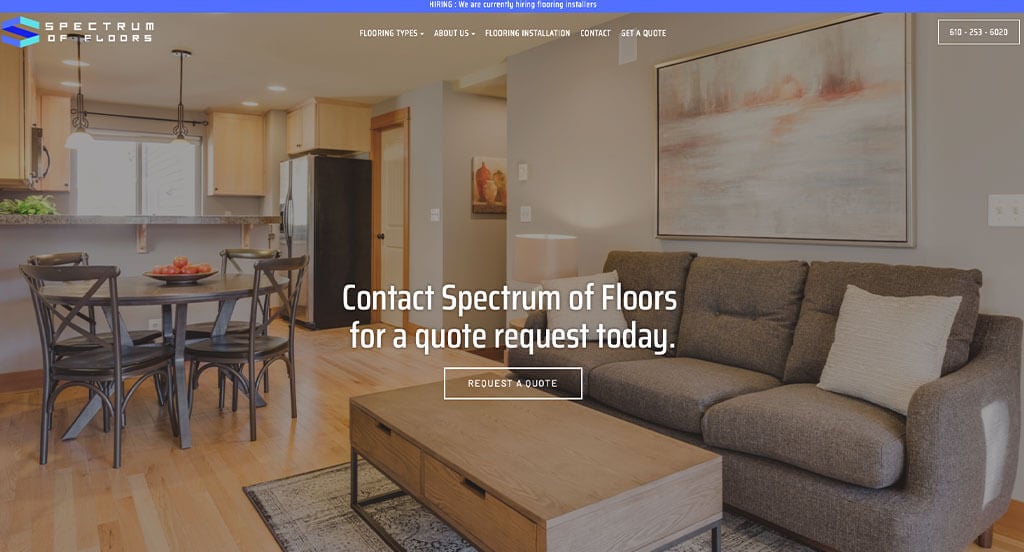
This is a great flooring web design example for someone who is looking for a professional layout. One of the homepage features of Spectrum of Floors we noticed was their use of dotted graphics for the background because that isn’t something you find on most flooring websites. Another design quality in this custom flooring website was the interesting logo design. They clearly had a focus on website marketing when building the balance of imagery for their website. For flooring looking for ideas on their next website, this example will definitely be one to take a look at.
20. Floor World
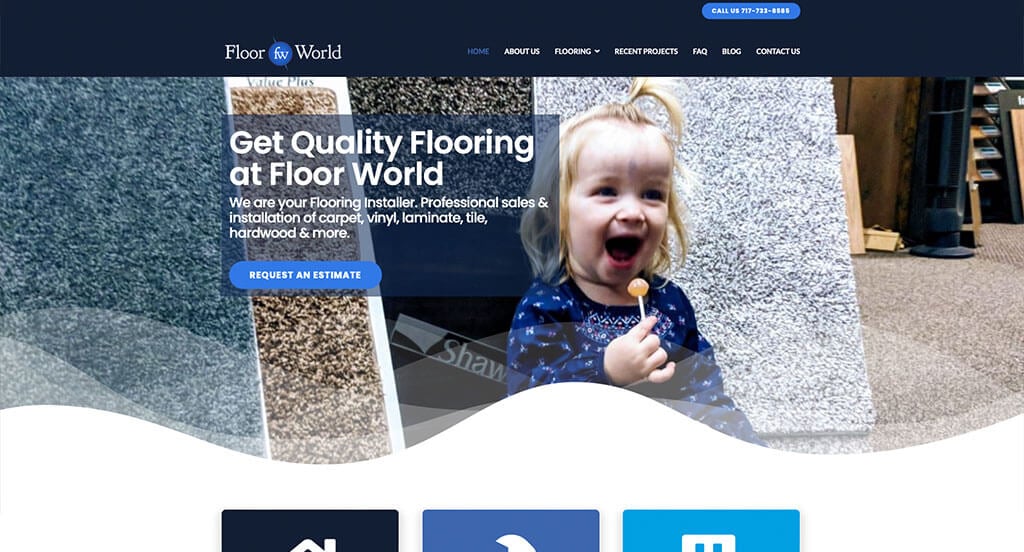
This is a great website design example for a flooring company looking for inspiration for their next custom site. The display of their hours was definitely the most impactful feature in the homepage of this website. The inclusion of social media was another feature in this professional flooring site we enjoyed. Floor World clearly had a focus on conversions when designing the use of an about us page for their website. If you are looking for template examples for your next flooring site, be sure to check this one out.
21. Havwoods
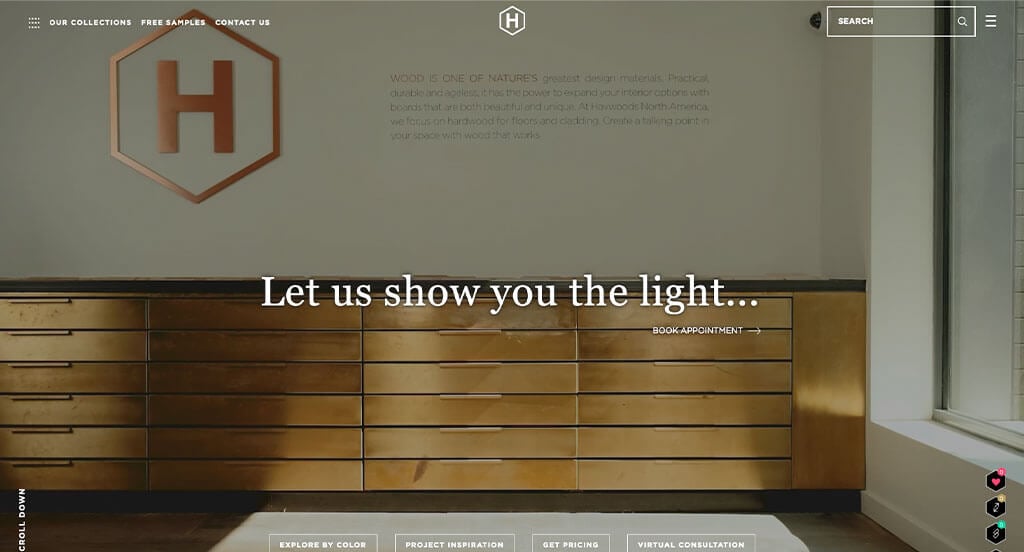
The Havwoods website has a very classy feel to it, thanks to its unique use of black and white. The look and feel of the homepage of this flooring website caught our attention because of their large imagery. Another design quality in this professional flooring site we liked was the links guiding viewers to other areas of the site. Havwoods clearly had digital marketing in mind when designing the clearly labeled menu for their website. Give some thought to the unique design of this flooring website when developing your next website.
22. LV Wood
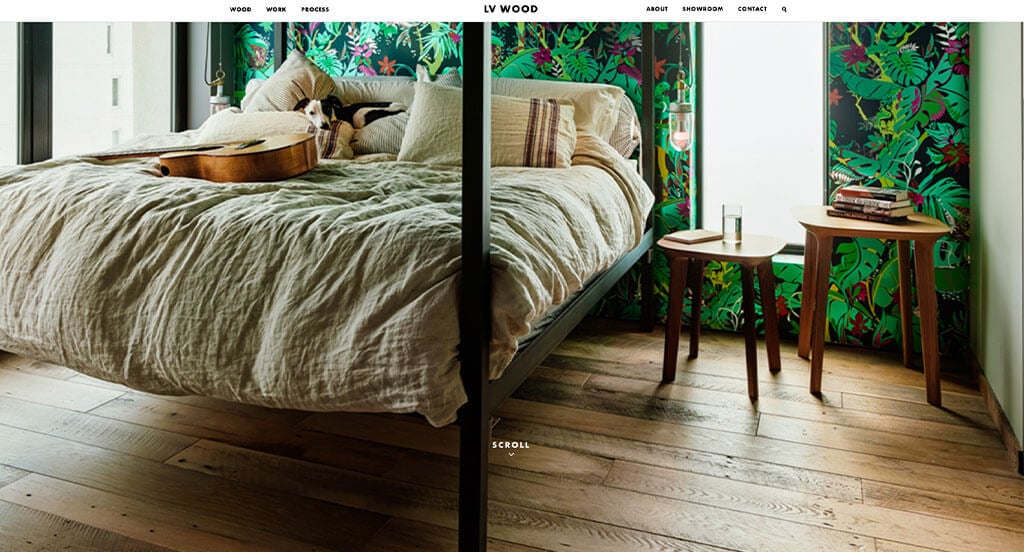
This is a great flooring web design example for someone who is looking for a professional layout. After scrolling past the navigation of this flooring site, you’ll notice buttons to enhance usability. Another thoughtful feature in this creative flooring website was the simple contact information. They clearly had a focus on website marketing when creating the page dedicated to their process. Don’t skip past this website when considering design ideas for your next flooring website!
23. PID Floors
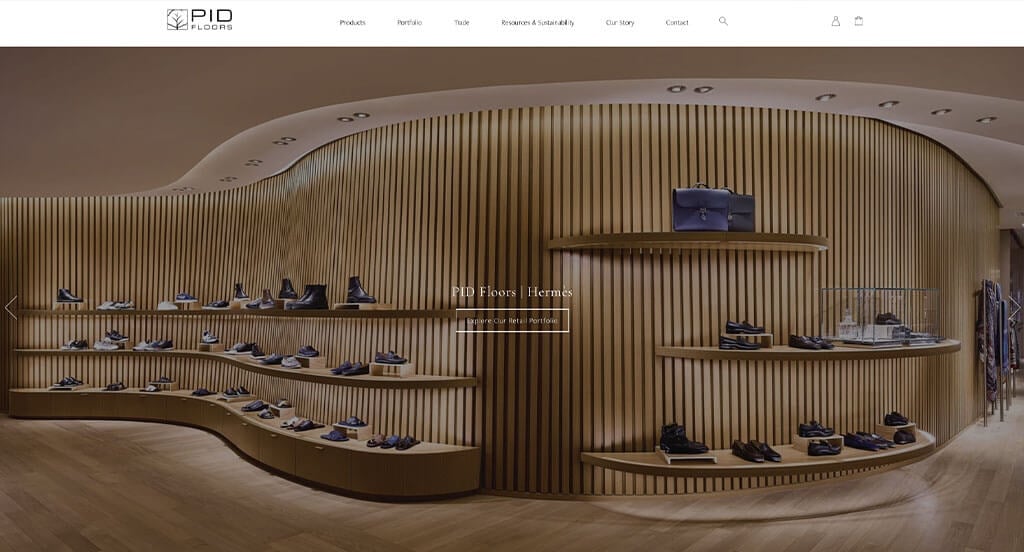
This is a great website design example for a flooring company that is looking to get inspired for their next custom layout. We thought this was a good homepage design example for flooring businesses because of the short and to the point paragraphs. The addition of bullet points was another design quality in this professional flooring site we enjoyed. They clearly had ease of use in mind when designing the domain for their website that matches their company name. Another amazing website to add to this list!
24. Show Flooring
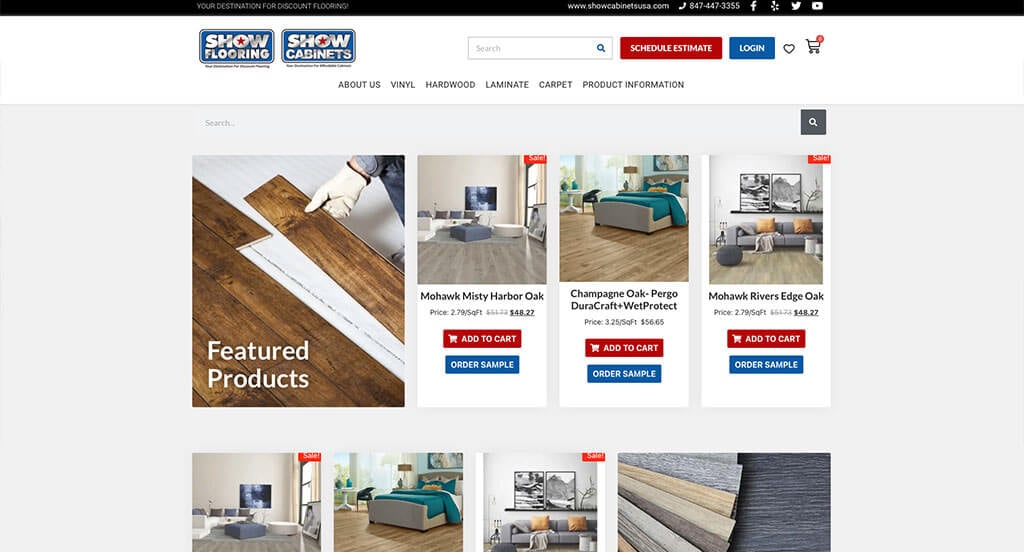
The website of Show Flooring ranked because it’s one of the nicer flooring websites we reviewed. The ability to add items to a cart was probably the most impactful quality in the homepage of this website. The addition of a search bar was refreshing for a unique flooring website. Show Flooring had digital marketing in mind when creating the simplistic template for their website. Any web designer developing websites for flooring companies will want to consider checking this website out.
25. Performers Flooring
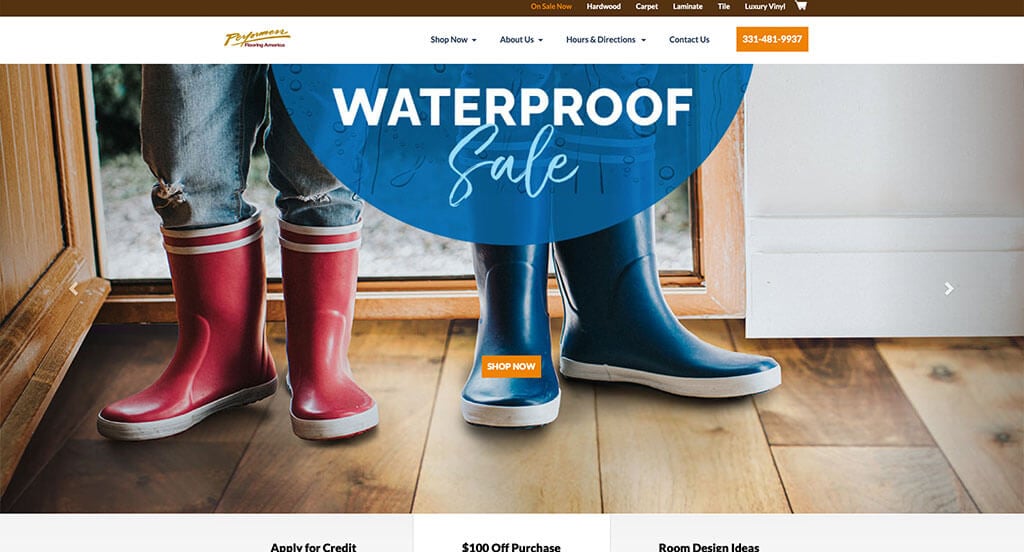
This is a good example of a flooring website design that can give inspiration to another company for their professional website. One of the homepage features in Performers Flooring we noticed was their orange accents because that isn’t something you find on most flooring websites. The use of a progression bar was a good choice for a unique site. They clearly had ease of use in mind when designing the bolded words in their website. Be sure to consider the unique design of this flooring website when developing your next website.
26. State of The Art Floors
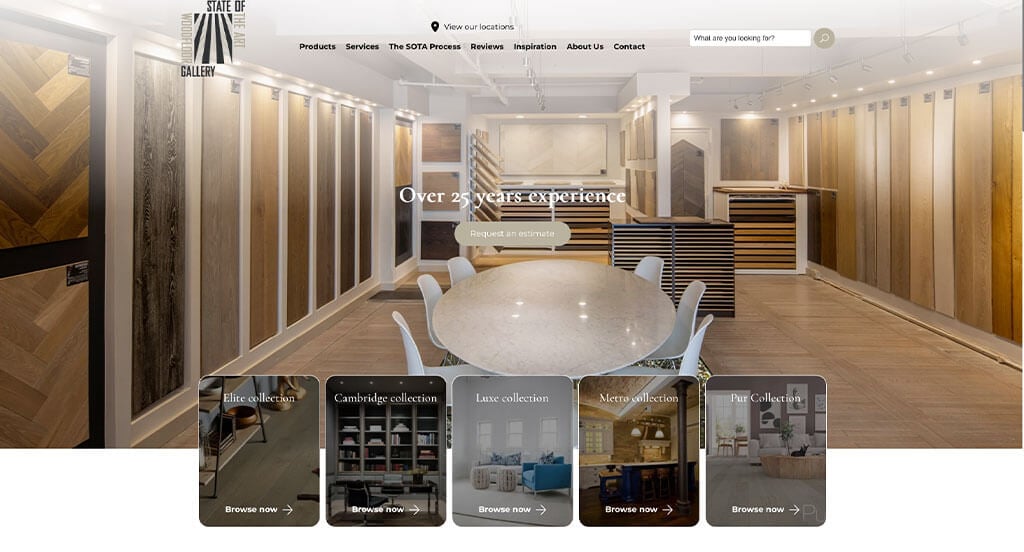
This is a good website example of a website design for flooring companies who are looking for a custom site layout. The creative layout was definitely the most impactful quality in the homepage of State of The Art Floors. Another thoughtful feature in this professional flooring website was the interesting logo design. They clearly had ease of use in mind when building the search bar for their website. If you are looking for template examples for your next flooring website, be sure to check this one out.
27. Fortis
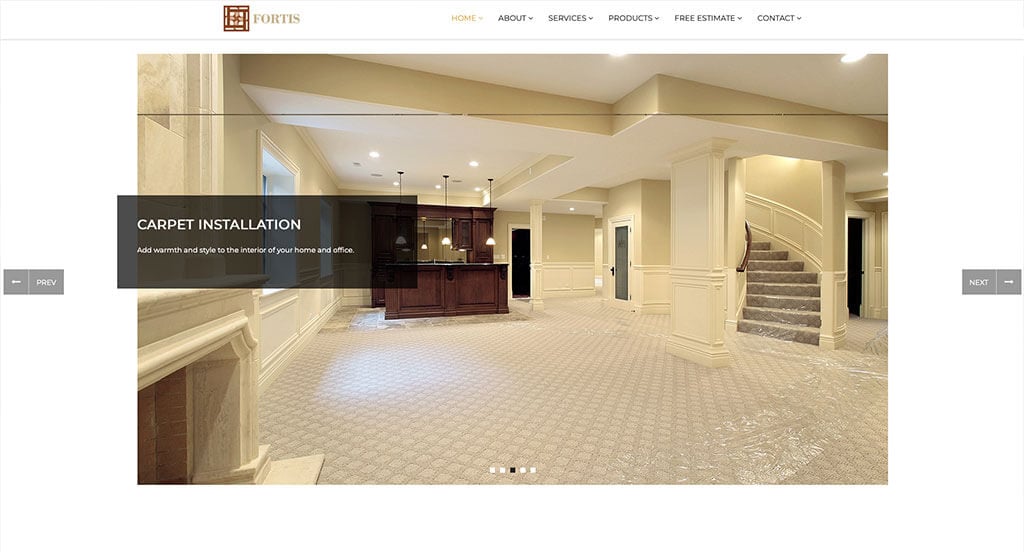
We liked how this flooring website combined the colors of a warm color palette for their custom web design layout. After scrolling past the header of this flooring site, you’ll immediately notice their creative logo design. The large imagery was a nice touch for a unique flooring site. Fortis had ease of use in mind when designing the well-labeled navigation bar for their website. There was no shortage of reasons to include this website in our list of websites for flooring to consider when building out their next website.
28. I.J. Pesier’s Sons
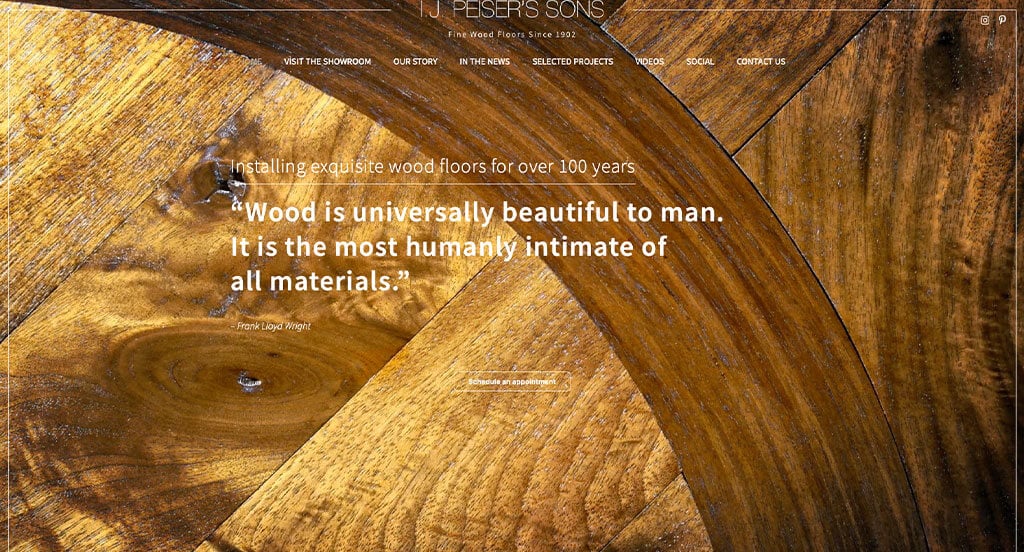
This is a great example for flooring companies who are looking for a professional website layout. The large imagery for the background was likely the most impactful feature in the homepage of I.J. Peiser’s Sons. The inclusion of videos was absolutely a consideration when ranking I.J. Peiser’s Sons in this list of top flooring websites. I.J. Peiser’s Sons clearly had digital marketing in mind when designing the simple contact information for their website. Give some thought to the creative design of this flooring website when developing your next website.
29. Carlisle Wide Plank Floors
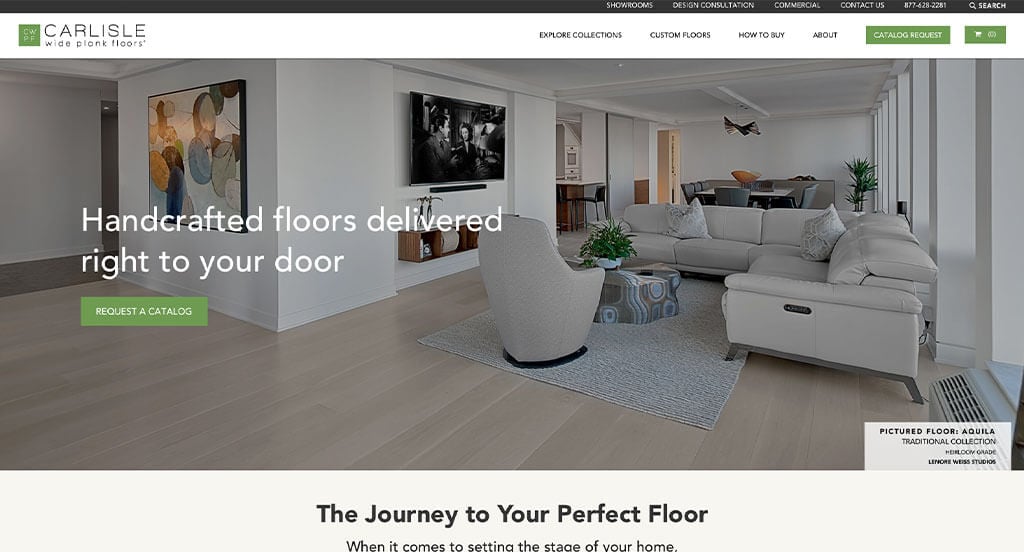
This is a great website design idea for a flooring company looking for a custom look and feel for their next web design template. Our web designers thought this website was a good design idea for flooring businesses because of their green accent color. The use of graphics was a nice choice for a professional flooring site. They had ease of use in mind when building the well-labeled navigation bar for their website. For the flooring out there checking website examples, make sure to check this one out!
30. U.B. Hardwoods & Flooring
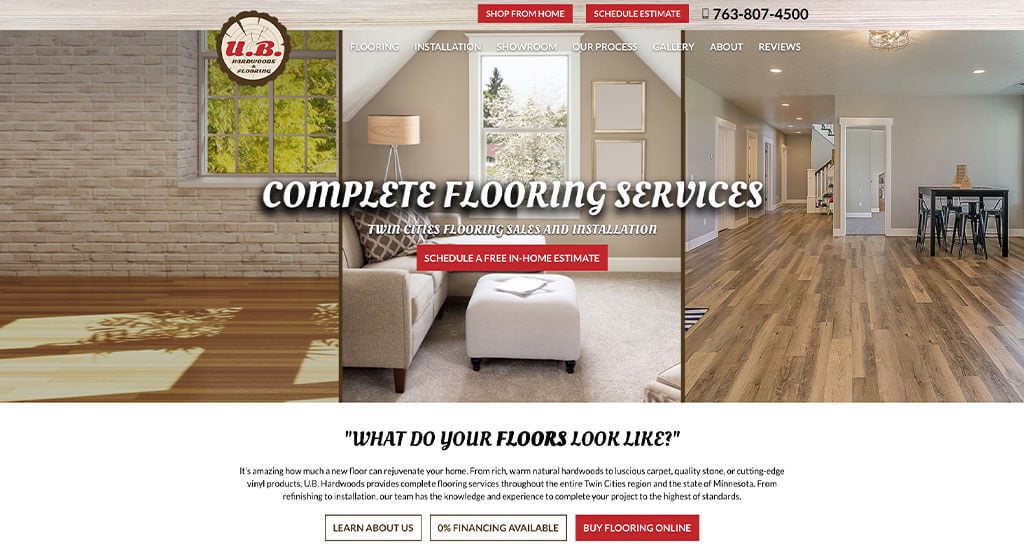
We appreciated how this flooring site used the colors of black, gray, tan, white and red to create an attractive website design. The layout of this flooring website was thoughtful because of their use of wood grain graphics. The interesting logo design was a unique choice for a professional flooring site. From a marketing viewpoint, we really liked the way this flooring website utilized professional fonts. What a great website to review when designing your next website!
31. All State Flooring
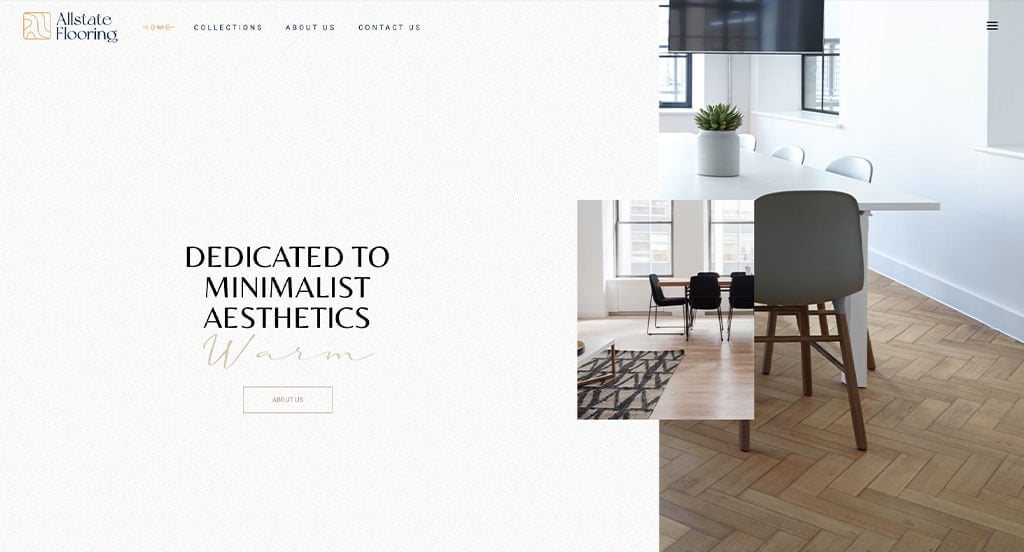
This is a great website design example for flooring companies who are looking for a custom website. After scrolling past the navigation of this flooring site, you’ll notice their template with a good balance of white space. The stunning visuals were refreshing for a custom website. They clearly had digital marketing in mind when creating the use of buttons for their website. With so many quality reasons to consider this flooring website, it’s obvious why we included it in this list of the best sites!
32. Carpet & Tile Mart
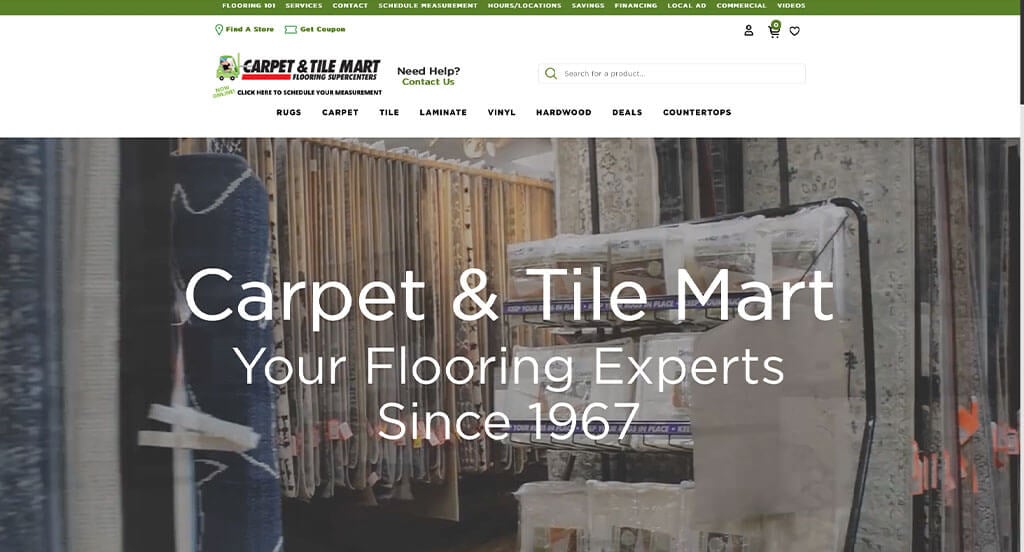
This is a good example of a website design for flooring businesses who are looking for a professional look and feel for their next website. The subtle animations were probably the most impactful quality in the homepage of this website. The bright accent colors were also an interesting choice for a custom flooring website. They clearly had a focus on conversions when building the graphics within their website. These were just a few of the numerous great qualities in this website we had to consider when putting together this list of top websites for flooring.
33. Baseman Floors
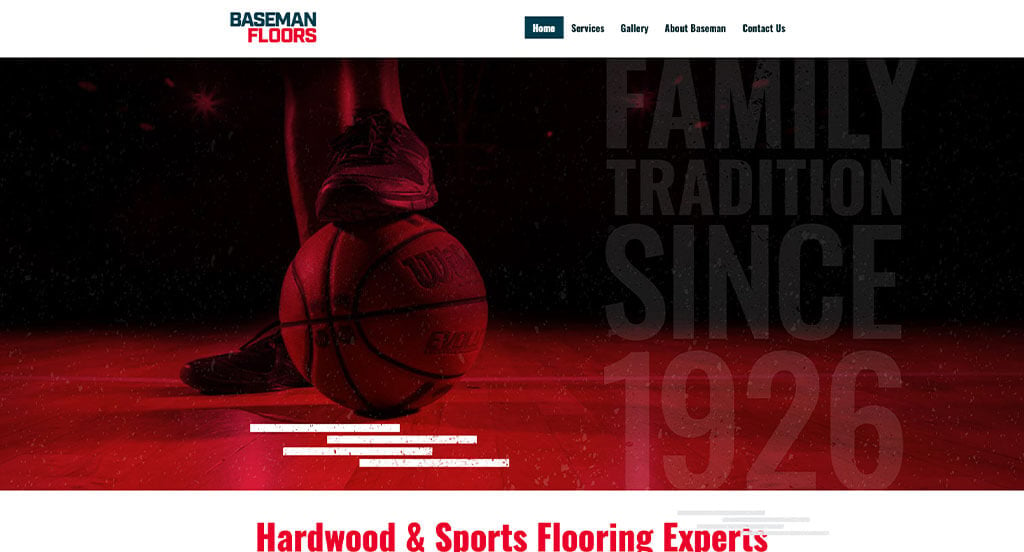
This is a great example for flooring companies to look at for their next custom website. Of all the professional flooring websites we reviewed, one of the features in this custom website we liked was their stunning imagery. Another design quality in this creative flooring website was their creative icons. Baseman Floors had website usability in mind when building the creative color palette for their website. Don’t skip past this website when considering design ideas for your next flooring website!
34. Carpet One Floor & Home
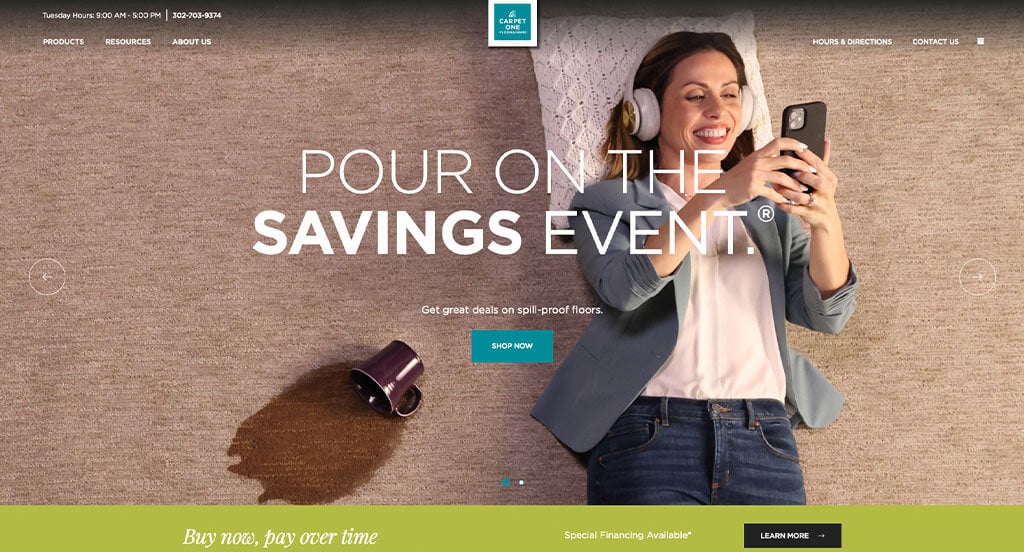
This is a good example of a website for a flooring company looking for custom web design layout ideas. After scrolling past the navigation of this flooring website, you’ll notice the use of an automatically playing video. The animations were a nice touch for a professional site. They had ease of use in mind when building the stunning accent colors for their website. Be sure to consider the one-of-a-kind design of this flooring website when building out your next website.
35. Avalon Flooring
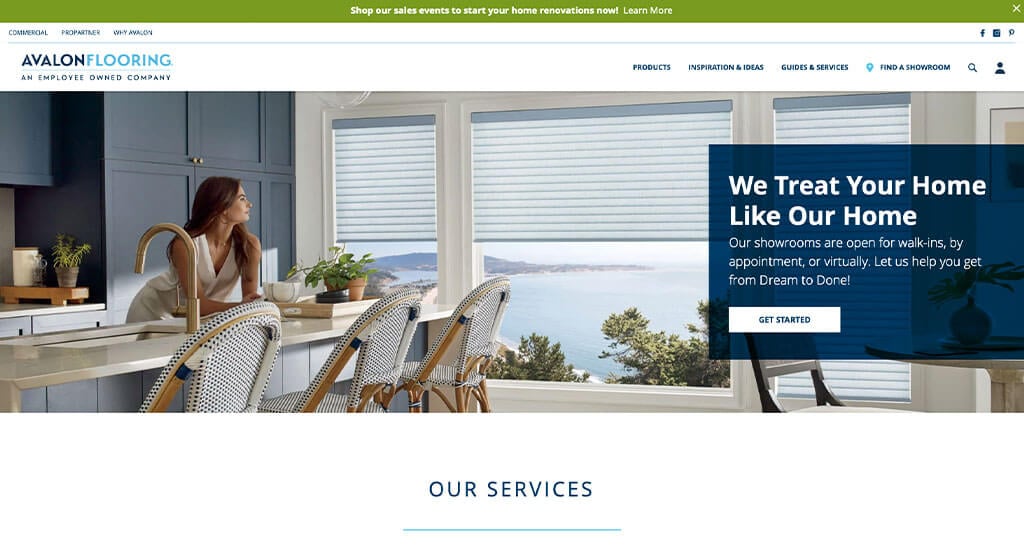
Showcasing a clean and intuitive layout, this site keeps things simple for a flooring website. As you scroll through the homepage, one of the qualities you’ll notice right away is their high-quality visuals. The short and to the point paragraphs were a unique choice for a professional website. Avalon Flooring had ease of use in mind when creating the domain for their website that matches their company’s name. There was no shortage of reasons to include this website in our list of websites for flooring to consider when building out their next website.
36. The Flooring Center
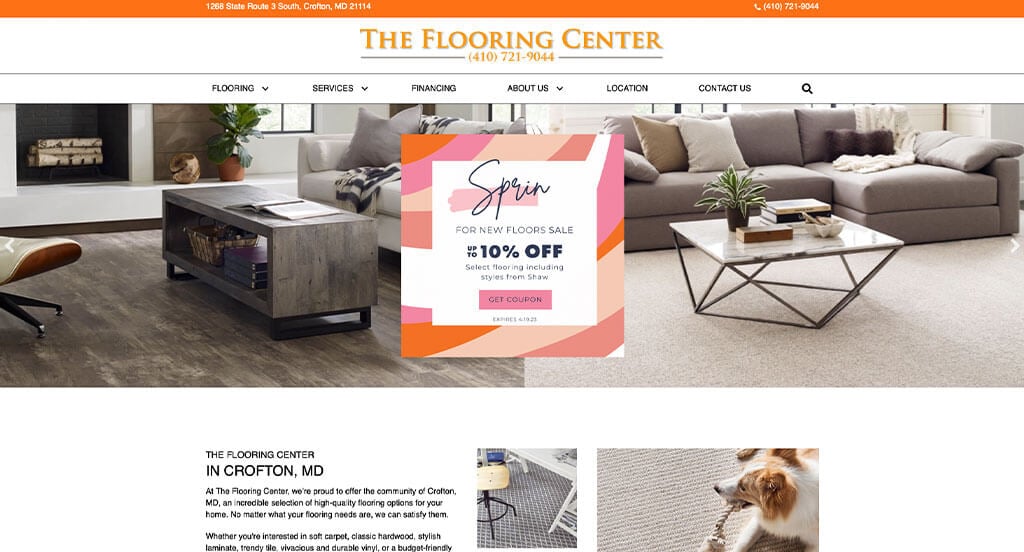
This is a good example of a website design for flooring companies who are looking for a professional look and feel for their next site. While most flooring websites share this quality, we thought The Flooring Center did a nice job of choosing a layout that was easy to navigate. This custom flooring site also does a good job with their contrasting accent color. They had conversions in mind when creating the variety of different fonts for their website. Give some thought to the creative design of this flooring website when building out your next website.
37. Floors Etc.
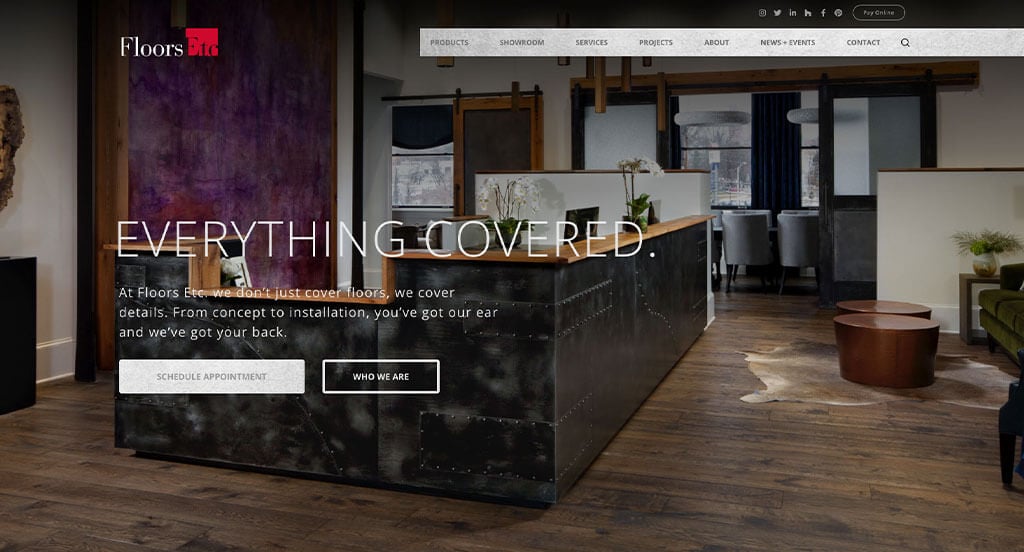
This is a great website design example for flooring businesses who are looking for a custom look and feel. Our web designers thought this website was a good design idea for flooring companies because of their use of graphics in the form of icons. The buttons to enhance usability was another thoughtful feature in this custom flooring site we enjoyed. Floors Etc. had website accessibility in mind when designing the clearly labeled menu for their website. If you are looking for template ideas for your next flooring site, give some thought to this one.
38. Craftmasters Flooring
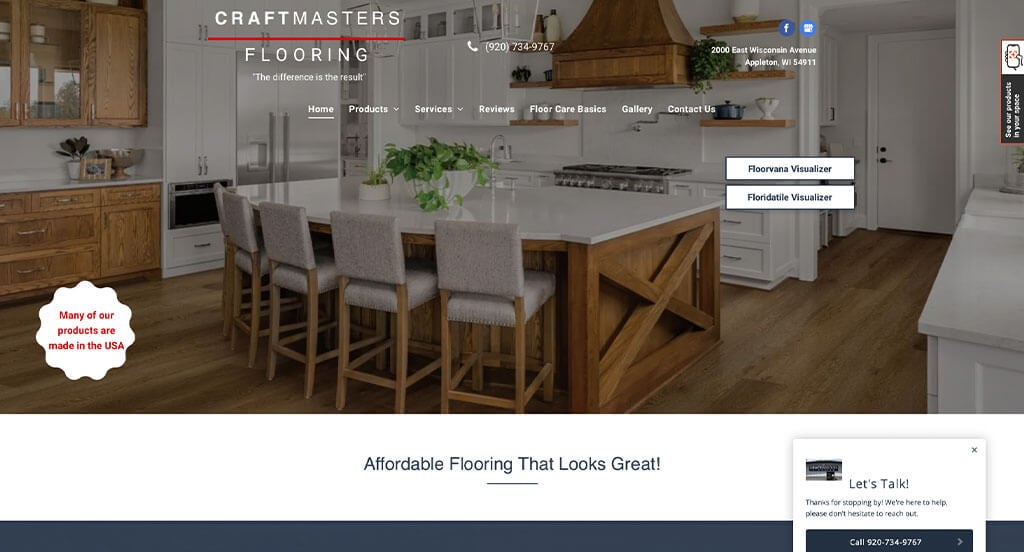
This is a good website example of a website design for flooring companies who are looking for a custom look and feel for their next site. The layout of this flooring website was thoughtful because of the relaxing color palette. Another feature in this custom flooring website was their page dedicated to their photos and videos. Craftsmasters Flooring had conversions in mind when creating the domain for their website that matches their company name. For the flooring businesses out there looking through website examples, make sure to check this one out!
39. Carpet City & Flooring
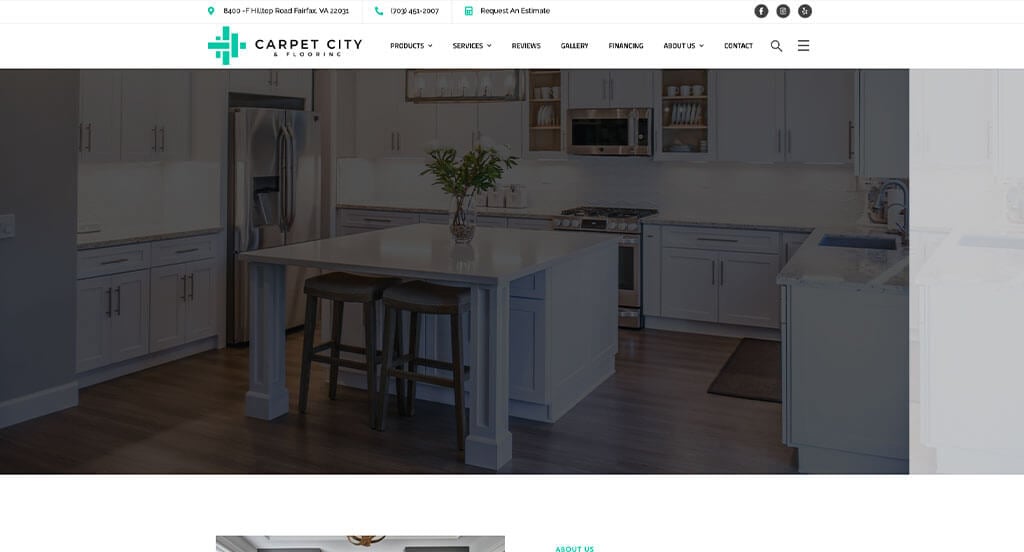
This is a good example of a website design for flooring companies who are looking for a professional website layout. As you scroll through the homepage of this website, one of the design qualities we liked was their creative logo design. The template that was well organized was another design quality in this custom flooring website we enjoyed. They clearly had website usability in mind when building the simple contact information for their website. Don’t forget to check this website out while looking through our list of the best flooring websites!
40. Affordable Carpet & Flooring
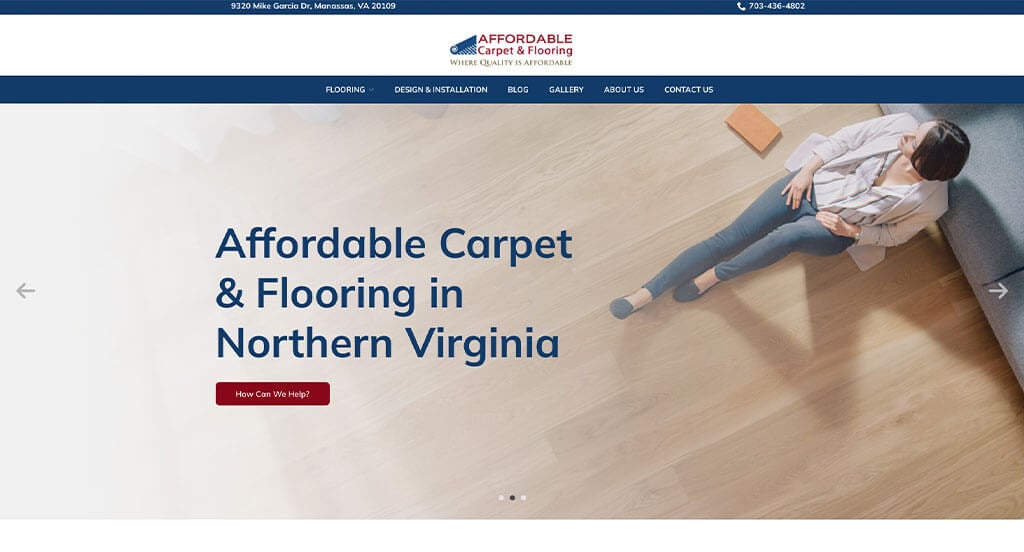
This is a great website design example for a flooring company looking to get inspired for their custom layout. Of all the professional flooring websites we reviewed, one of the features in this custom website we liked was the use of bullet points to organize information. The phone number displayed on the top of the page was a good choice for a professional website. Affordable Carpet & Flooring clearly had digital marketing in mind when designing the stunning template for their website. Be sure to consider the creative design of this flooring website when building your next website.
41. Creative Flooring Solutions
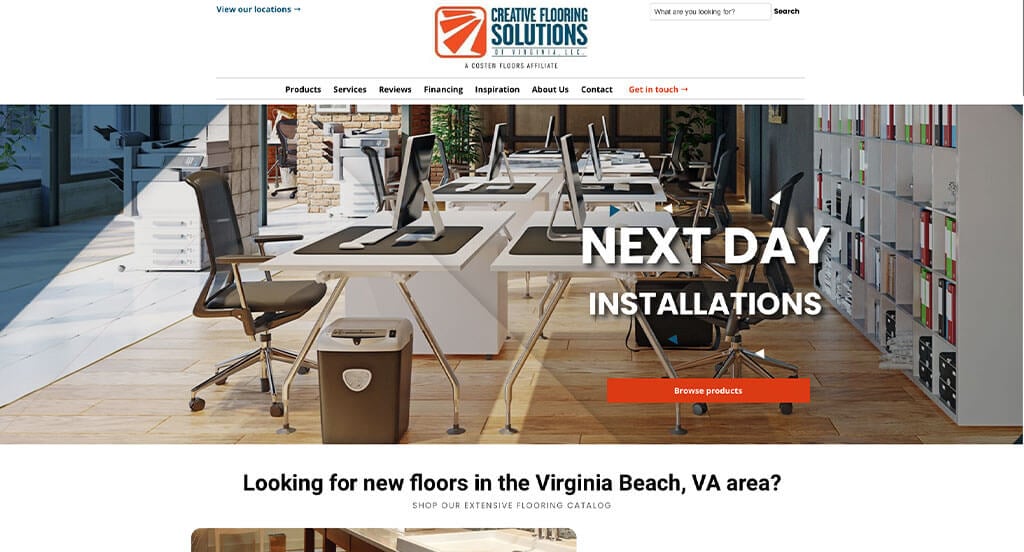
The website of Creative Flooring Solutions ranked because it’s one of the better looking flooring websites we came across. As you scroll through the homepage of this website, one of the qualities you’ll notice right away is their staggered layout for their imagery. The professional fonts were a unique choice for a custom site. The domain for their website that matches their company’s name helped make this one of the best flooring websites we considered. Another amazing website to add to this list!
42. Total Flooring Inc
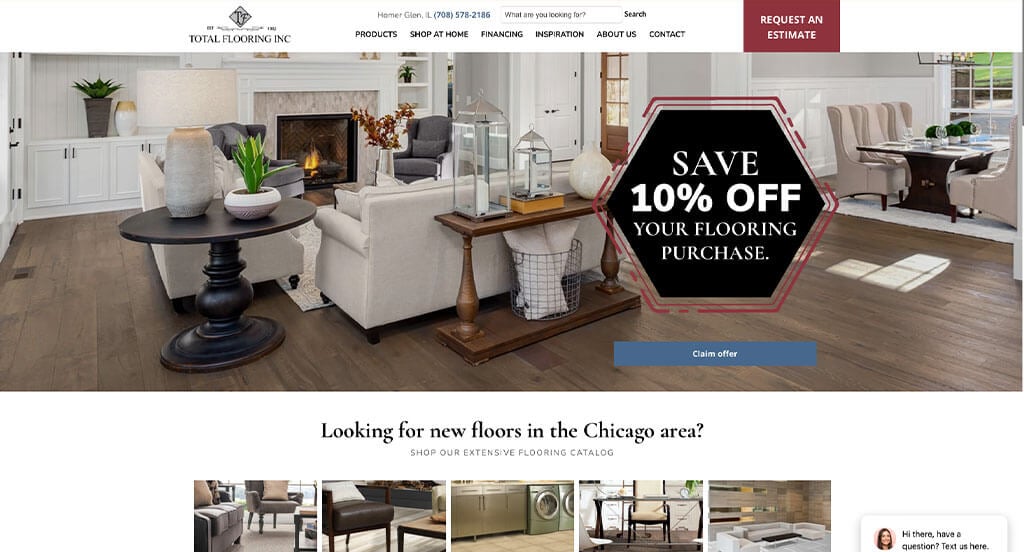
The white, gray-ish blue and green color scheme for this flooring site stood out to us because it creates a dulled down but still professional template. The most attention grabbing aspect in this flooring website was definitely the section for FAQ. The larger text for their titles was another design quality in this professional flooring website we enjoyed. Total Flooring Inc clearly had website marketing in mind when designing the short and to the point paragraphs for their website. With so many good reasons to consider this flooring website, it’s obvious why we included it in this list of the best websites!
43. Jerry’s Floor Store
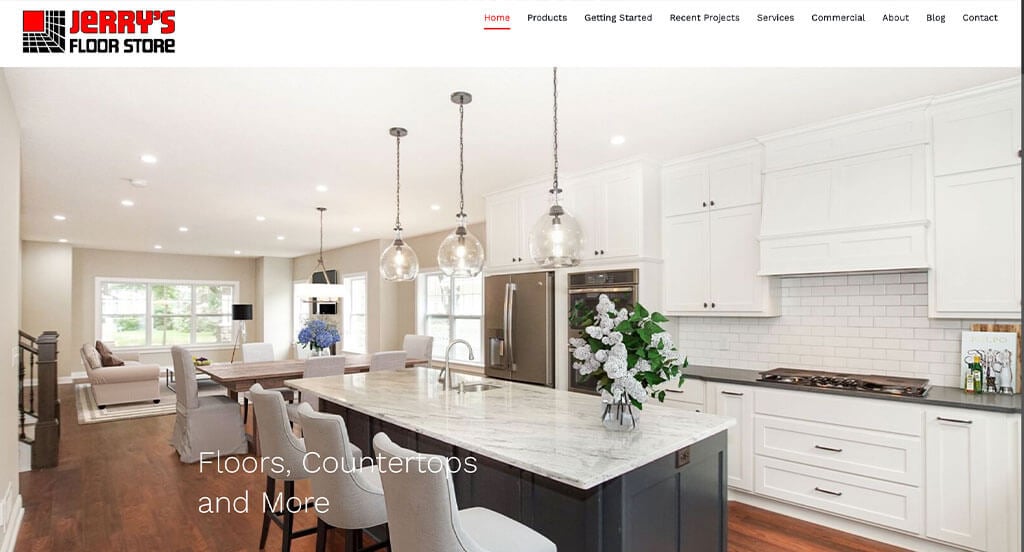
This is a good example of a website design for flooring companies who are looking for a professional look and feel for their next website. Of all the professional flooring websites we reviewed, one of the features in this custom website we liked was the professional imagery. The display of different awards helped viewers gain trust in this custom site. Jerry’s Floor Store clearly had a focus on website marketing when creating the blog for their website. There was no shortage of reasons to include this website in our list of websites for flooring companies to consider when developing their next website.
How to Build a Great Flooring Website
Are you in the process of building a new website for your flooring company? How exciting!
Let’s walk through some of the most important steps in building a new or redesigning an existing flooring company website.
Feel free to skip the first few sections if you already have a domain name, hosting service, and website platform picked out!
1.) Purchasing a Domain Name
Picking out a domain name for your flooring website is a crucial step in establishing your company’s online identity. It serves as the address that visitors will use to access your flooring website and plays a significant role in branding and recognition.
Here’s a step-by-step process to help you choose the perfect domain name:
- Brainstorm: Start by brainstorming ideas for your domain name, considering the name of your business, the type of flooring services you offer, and your location.
- Simplicity: Try to keep your domain name simple, easy to spell, and pronounce. Avoid using complex words, hyphens, or numbers.
- Consistency: If your business has an established brand name, it’s generally a good idea to include it in your domain name. For example, if your business name is Big Acorn Flooring, don’t register a domain name like FloorsAndMore.biz.
- Availability: Check the availability of your desired domain names before proceeding. Most common domain names have already been registered. If that’s the case, see if your desired domain name is being used and available for sale. However, be cautious not to invest too much money in buying a domain name that’s for sale.
- Domain Extensions: Consider which domain name extension best suits your website’s purpose. While .com is the most common and widely recognized extension, there are other options available, such as .net, .org, or industry-specific extensions like .flooring.
- Legal Considerations: Before registering your domain name, conduct a trademark search to ensure it doesn’t infringe upon someone else’s intellectual property. For example, avoid registering a domain name that includes another flooring company’s business name or the name of a popular flooring product brand.
- Register the Domain: Once you’ve settled on an available domain name, it’s time to register it through a reputable domain registrar. We’ve found GoDaddy and Namecheap to be the most user-friendly domain registrars.
2.) Choosing a Website Platform
After figuring out your domain name, the next step is selecting a website platform for your flooring company’s website.
Most flooring contractors are going to build content-based websites with phone numbers, contact forms, live chats, and appointment schedulers to drive conversions.
You’ll typically only see flooring companies adding ecommerce if they are trying to sell flooring materials online. That isn’t incredibly common though, since the shipping weight and size of carpet rolls, vinyl rolls, and ceramic tiles makes it hard to turn a profit. Most flooring contractors leave that type of online selling to big box retailers, and instead focus on showroom sales.
For Service-Based Websites:
Most flooring contractors will find WordPress to be an excellent platform choice. However, there are also options like Wix and other hosted website builders.
- WordPress: WordPress is a versatile and widely used content management system (CMS) that offers tremendous flexibility and customization options. It caters to all types of flooring company websites, from simple brochure-like sites to more complex sites with galleries and project portfolios. With thousands of flooring-inspired themes and helpful plugins available, WordPress allows you to create a highly customized website tailored to your flooring company’s needs. It’s a great choice if you value control and want the ability to expand your website’s functionality over time. Although there is a hosted version of WordPress, most people who use WordPress have the open-source version installed on a web hosting account.
- Wix: The Wix platform offers many of the same page-building features. It is also a hosted solution. We have worked on flooring websites built on Wix, and it is a solid page builder that we confidently recommend. With Wix, you won’t need a separate web hosting service.
For Ecommerce Websites:
If your flooring company sells products online, you’ll likely find either WooCommerce or Shopify to be suitable options.
- WooCommerce: If you plan to build an online store for your flooring business using WordPress, WooCommerce is the ideal ecommerce plugin to install. It seamlessly integrates with WordPress, allowing you to add ecommerce functionality to your flooring company’s existing website. WooCommerce offers a wide range of extensions, payment gateways, and inventory management tools, making it a great choice for flooring businesses looking to sell products online.
- Shopify: The Shopify platform is a leading ecommerce solution that provides everything you need to create and manage an online flooring business. It is a hosted ecommerce platform, eliminating the need to find a separate web hosting service. Like other ecommerce solutions, it offers a user-friendly interface, customizable themes, built-in security, and a range of features for inventory management, payments, and shipping.
Web Hosting Requirements
If you choose a platform like WordPress or WooCommerce, you’ll need to find a web hosting service.
As a suggestion, we recommend our own web hosting service, which is optimized for WordPress websites. Alternatively, here are some recommendations for reliable web hosting services from other hosting companies:
- WP Engine: This is one of our favorite web hosting services for flooring companies. WP Engine offers a great control panel that simplifies the process of creating staging websites. Their backup process is also seamless. The only downside we’ve noticed is the limits they place on PHP max_execution_time. Additionally, their pricing can increase quickly if you require upgraded services.
- SiteGround: We’ve always enjoyed working with SiteGround. Their live chat and email support are excellent compared to more well-known hosting firms. We’ve never had to wait long to get in touch with someone, and the first person we interact with usually solves the issue. Their backup tools are also user-friendly, and they offer reasonable pricing for flooring companies.
- Digital Ocean: This is a great option for cloud hosting, although it may be too advanced for most flooring company websites. We’ve never encountered issues with the Digital Ocean cloud network, unlike other cloud networks we’ve tried. Cloud hosting can be expensive when factoring in droplet (server instance) costs, operating system, control panel, server software, offsite backup, and server management fees. If you need server administration assistance, we recommend checking out AdminGeekZ.
3.) Selecting a Website Template
Many flooring contractors prefer to purchase and customize a pre-built website template as it significantly reduces web development costs and turnaround time. However, if your company prefers a custom design, you can always hire a custom web developer or custom ecommerce developer to build a theme from scratch.
To guide you through setting up your flooring website, let’s focus on suggestions for finding a pre-built website template. Here are some links to the main theme marketplaces:
WordPress Flooring Themes
You can find free themes at wordpress.org, or consider flooring-inspired templates on ThemeForest.
Flooring – Themeforest
$69
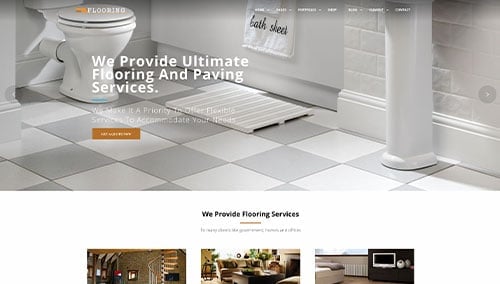
TileMax – Themeforest
$69
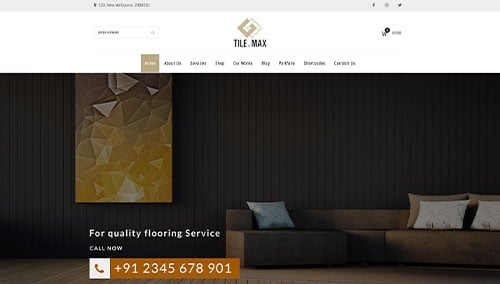
Mahogany – Themeforest
$69
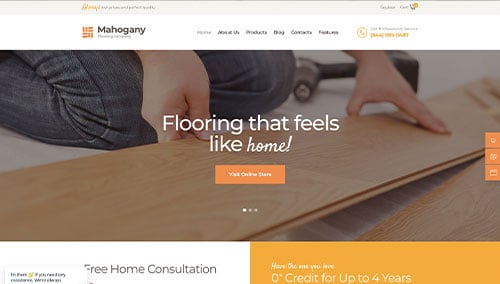
Alori – Themeforest
$49
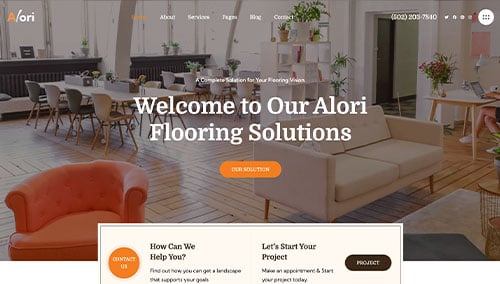
WooCommerce Flooring Themes
You’ll find plenty of ecommerce flooring themes for WooCommerce on ThemeForest.
Shopify Flooring Themes
You can find free and paid themes at themes.shopify.com, or explore options on marketplaces like ThemeForest.
Tileo – Themeforest
$58
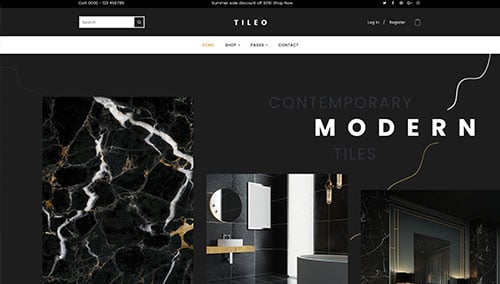
Safex – Themeforest
$59
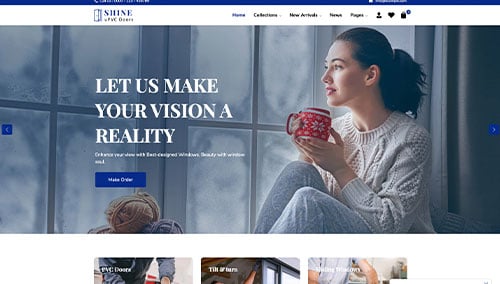
Wix Flooring Themes
You can find free and paid themes in the Wix marketplace at wix.com, some of which are suitable for flooring contractors.
4.) Crafting Content & Incorporating Images
Now that you’ve secured your domain name, chosen your website platform, and selected a theme, it’s time to start developing compelling content for your flooring company’s website!
Here are some valuable tips to help you create engaging and effective website copy:
- Know your target audience: Before writing a single word, gain a deep understanding of your target audience’s demographics, preferences, and needs. Tailor your content to address their pain points, provide value, and resonate with them. This will enhance your visibility in search engines for flooring-related queries that are relevant to your business.
- Define your key messages: Determine the primary messages you want to convey through your website content. These messages should align with your brand, highlight your unique advantages, and clearly communicate the benefits of your flooring products or services.
- Keep it concise and scannable: Online readers tend to skim content, so ensure your writing is concise and easily digestible. Use short paragraphs, bullet points, subheadings, and bold text to break up the content and improve readability.
- Create clear and compelling headlines: Craft attention-grabbing headlines that immediately communicate the value and relevance of your flooring business. A well-crafted headline can entice visitors to explore your website further and learn more about your offerings.
- Incorporate keywords strategically: Conduct research on relevant keywords and seamlessly integrate them throughout your content. This can enhance the visibility of your flooring website in search engine results. However, avoid keyword stuffing, as it can negatively impact readability and user experience. Tools like Ahrefs or Semrush can assist with keyword research.
- Maintain a conversational tone: Write in a conversational manner that resonates with your flooring audience. Avoid jargon or overly technical language unless your target audience specifically requires it. Engage your readers by addressing them directly and adopting a friendly, approachable style.
- Edit and proofread: Always edit and proofread your content before publishing. Check for grammar, spelling, and punctuation errors. Ensure the flow of your content is smooth, logical, and aligns with your brand voice and style guidelines. Tools like Grammarly can assist you in this process.
- Leverage ChatGPT for assistance: If you need help generating ideas or refining the content on your flooring website, consider utilizing AI tools like ChatGPT.
Additionally, incorporate relevant, high-quality images into your content to enhance its appeal. Consider the following tips:
- Utilize high-quality images: Opt for visually appealing, well-composed, and high-resolution images. Avoid blurry or pixelated images that could detract from the overall quality of your flooring website.
- Ensure relevance: Select images that are directly relevant to your content and effectively illustrate your message. The images should enhance the text and provide additional context or visual interest for your flooring company.
- Explore stock photo resources: Take advantage of reputable stock photo websites like Unsplash, Pixabay, or Shutterstock to discover a wide range of professional-quality images relevant to the flooring industry. Be mindful of licensing requirements and attribute images as necessary.
- Customize images when possible: If you have the resources or skills, consider customizing or branding images to align with your flooring company’s brand. This can create a cohesive visual experience for your visitors. Tools like Adobe Photoshop or Canva can be helpful in this regard.
- Optimize image file sizes: Compress images to optimize their file sizes without compromising quality. Large image files can slow down your flooring website’s loading speed, negatively impacting user experience and SEO. Tools like TinyPNG can assist with image compression.
5.) Post-Launch Strategies
Once you’ve built and launched your flooring company’s website, there are several important tasks and services to consider in order to maximize its effectiveness. Here are some essential suggestions to guide you through post-launch activities:
- Search Engine Optimization (SEO): Implement effective SEO strategies to enhance the visibility of your flooring company in local search results. Conduct keyword research, optimize your content, and ensure a solid internal linking structure. Regularly update and create fresh, high-quality content to attract organic traffic. Consider our SEO team or explore services like The HOTH for assistance.
- Paid Advertising: Drive targeted traffic to your flooring business by utilizing paid advertising platforms such as Google Ads or Facebook Ads. Consider our PPC management services or find talented professionals on platforms like Mayple for faster results.
- Conversion Rate Optimization (CRO): Analyze your flooring website’s performance and user behavior using tools like Google Analytics. Identify areas where users may drop off or encounter barriers to conversion. Conduct A/B testing with tools like VWO to make data-driven changes that improve conversion rates and enhance the user experience.
- Website Security: Safeguard your flooring website from malware and other security threats. Implement robust security measures such as SSL certificates, web application firewalls (e.g., Sucuri), and regular backups. Keep your CMS, plugins, and themes up to date to minimize vulnerabilities. Monitor your website’s uptime using services like UptimeRobot.
- Website Maintenance: Regularly maintain your flooring website to ensure optimal performance. For WordPress users, this includes updating plugins and themes, monitoring website speed and performance, and resolving any broken links or errors. Consider our website maintenance services or find freelancers on platforms like Upwork to handle these tasks. Regularly backup your flooring website to protect against data loss or technical issues.
- User Feedback and Testing: Actively seek user feedback to understand visitor experiences and identify areas for improvement. Implement user testing to gather insights on how users interact with your flooring website. Utilize this feedback to make iterative enhancements and continuously optimize the user experience.
- Content Updates: Keep your website content fresh and up to date. Regularly publish new blog posts related to flooring, update product or service information, and ensure all information is accurate and relevant. Engaging and valuable content not only attracts visitors but also encourages return visits and content sharing among those interested in flooring.
Remember, post-launch digital marketing activities are crucial for the long-term success of your flooring website. Stay proactive, monitor performance, and adapt your strategies to achieve your business goals and meet the needs of your audience.